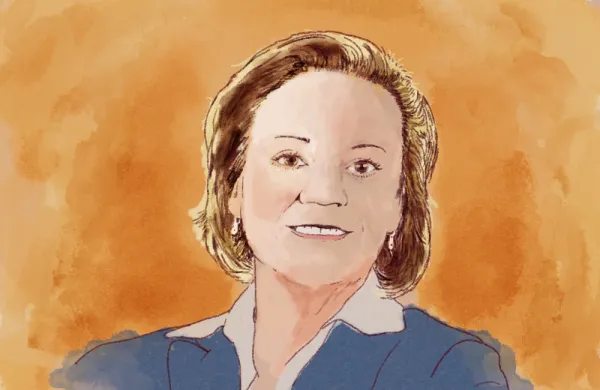If Jonathan Bock put on a conference, work friends warned, the only attendee would be Jonathan Bock.
He is the undisputed guru of an esoteric financial lending structure — business development companies — and he believed there were BDC-curious investors out there who should know more than the vehicle’s reputation for outsize returns and complexity.
As one investor puts it, “BDC: that stands for ‘Be. Damned. Careful.’”
In 2013, Bock, a Wells Fargo & Co. research analyst and managing director, and his employer put together the inaugural forum, booked the rooftop room of New York’s St. Regis, and hoped for the best.
“I expected 100 people to show up, and 300 came,” Bock recalls, his grin audible over the phone. “Wow, was it hot in that room. That first year, it was basically a few BDC managers, the SEC’s investment management head, Norm Champ, and Steve Schwarzman. The year after, we moved to two days at the Plaza and had 600 people. Then 900. Last year, we hosted over 1,215.” Attendees in 2016 included Goldman Sachs CEO Lloyd Blankfein, Wells Fargo CEO Tim Sloan, Apollo Global Management co-founder and CEO Leon Black, Providence Equity Partners CEO Jonathan Nelson, TPG co-founder David Bonderman, Avenue Capital Group CEO Marc Lasry, Blackstone CEO Schwarzman and head of credit Bennett Goodman, and former New York Yankees manager Joe Torre.
The hottest sector, by far, for large investors is direct lending — when anyone but a bank or a brokerage firm lends money to another company — as Institutional Investor research found in late 2016. Banks used to be the main lender to the middle market (firms earning $10 million to $100 million per year) but have backed away since the financial crisis. And institutional investors have eagerly stepped in.
“They’re looking at a return closer to 10 than to 0, on a floating rate, and you don’t have to sit around for five years to realize those numbers,” says Steve Nesbitt, CEO of alternatives advisory firm Cliffwater. Says a top-performing manager, Nesbitt is “the one consultant worth listening to on BDCs.” There are two main avenues for investors to get their money to middle-market lenders, who do the serious legwork of sourcing deals, assessing creditworthiness, and negotiating loans. The first is private partnerships, which operate as they do in private equity, with the general partner putting limited partners’ capital to work.
Then there are BDCs — similar to real estate investment trusts — for direct lending. Created by Congress in 1980, the idea was to stimulate lending to U.S. middle-market companies. BDCs can be publicly listed or private, and they pass income through to investors tax-free. “The great thing about BDCs is these are 40-ACT vehicles, are SEC-registered, must report performance, and file 10-Ks,” Nesbitt says. “For institutional investors concerned about transparency, it’s great here.”
Registering and filing reports with the Securities and Exchange Commission hasn’t convinced everyone that BDCs are safe investments. “Fraudiest Industry,” a Twitter poll by @WallStCritic asked in May, gathering more than 600 votes: “Pre-revenue Biotech (32 percent), Junior Miners (28 percent), BDCs (21 percent), Pre-revenue Tech (19 percent).” Nesbitt, Bock, and all other BDC-savvy experts interviewed dispute this aspect of the vehicle’s reputation. “These managers aren’t fraudy,” Nesbitt says. “It’s hard to be a fraud and be SEC-registered. Are there practices that, while compliant with the SEC and the BDC rules, are anti-shareholder? Yes. You just have to know what those practices might be. And you want to steer clear of those.”
BDCs feel like opposite land for sophisticated allocators. Retail investors discovered the middle-market lending frontier, and institutions are trying to settle it. But many encountered the “anti-shareholder” practices Nesbitt refers to and turned on their heels back to private partnerships. Fee loads and structures apparently tolerated by mutual funds or individuals, for example, flabbergasted UPS’s Greg Spick. Head of private markets for the courier’s $36 billion pension fund, Spick and senior portfolio manager Robert Thompson began following the sector closely in 2014. They saw a trove of serious talent in BDCs. “But it is incredibly expensive,” he says. “A lot of people are making a lot of money.”
Two fee practices common among BDCs are unheard of elsewhere in private markets, note Spick and Bock: charging a management fee (typically 1.5 percent) on total assets, including those financed through leverage (capped at 1-to-1 for BDCs). In contrast, private equity firms charge management fees on committed capital — or the equity portion only. When an investment vehicle’s fee practices make private equity look good, it may have a problem.
“The second piece of this that’s critically important is incentive compensation. A lot of BDCs do not have a look-back provision that takes into account the capital losses on their assets,” Spick says. “Pretend I’ve invested $500 in a BDC, with one turn of leverage. On that $1,000 in total assets, say interest income should be $50, but 10 percent aren’t paying. They’ve got problems, so we are only earning $45, or 9 percent,” he says. “If my hurdle rate is 7 percent, I would pay 20 percent of the income over the 7 percent, even though I know I may take an impairment on that 10 percent of nonperforming loans. My total return actually falls below my hurdle rate.”
In other words, many BDCs charge performance fees on capital they end up losing. Both Spick and Bock get wound up just explaining the model.
One of the most respected BDCs, Golub Capital, changed this aspect of its fee model in 2014, and some others have followed. “We simply added a cap to everybody else’s fee structure,” says David Golub, the firm’s president. “The cap says that we won’t earn an incremental dollar of incentive fees if, after doing so, we would have taken more than 20 percent of cumulative, pre–incentive fee net income. Many people told us, ‘Oh, it’s too complicated. You can’t do that.’ It’s not complicated. It’s simple. We’re in the long-term win-win business.”
Ask anyone steeped in BDCs to name top managers, and you will hear the same short list: Golub, Ares Capital, TPG Specialty Lending, and Owl Rock, plus one or two personal favorites. Goldman Sachs gets credit, as well, as other investment giants — Apollo, for example — launched BDCs that haven’t lived up to the quality of the core brands. (Apollo’s BDC has made strides recently on fees, Bock notes. A spokesperson for Apollo declined to comment.)
The bottom-feeders of the industry, experts say, are “zombie BDCs.” These listed BDCs trade well below their respective net asset values and do so for a long time, Bock explains, indicating that either the market doesn’t believe their valuations or it values their assets less because of who’s managing them. Year after year, zombies rake in large fees for poor performance, and capital dwindles but doesn’t flee. Several firms have succeeded in pushing BDCs to advisers managing individual retirement accounts, who in turn recommend them to individual investors. For BDCs the good-governance mechanism of activist investors doesn’t exist. No hedge fund, mutual fund, or other investment firm can own more than 3 percent of another, per 40-ACT rules. A pension fund or endowment could play BDC Bill Ackman, but it hasn’t happened yet. And so the zombies lumber on.
There are grown-ups in the BDC room, those with the talent and track records to rake in institutional capital (at institutional fee levels). But, as one of these grown-ups quips, “It’s a big room.”






